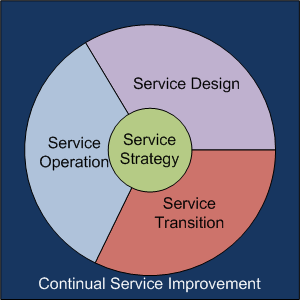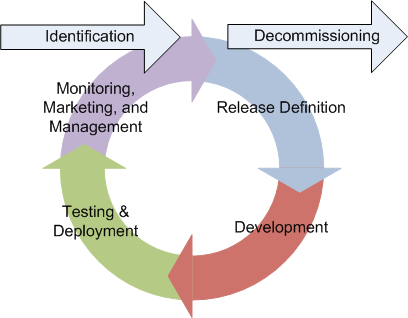 ITIL and SOA
ITIL and SOA
I’ve been involved in some discussions recently around the topic of ITIL Service Management. While I’m no ITIL expert, the little bit of information that I’ve gleaned from these discussions has shown me that there are strong parallels between SOA and ITIL Service Management.
There’s the obvious connection that both ITIL Service Management and SOA contain the term “service,” but it goes much deeper than that (otherwise, this wouldn’t be worth posting). There are five major domains associated with ITIL: service strategy, service design, service transition, service operation, and continual service improvement. Here’s a picture that I’ve drawn that tries to represent them:

Keeping it very simple, service strategy is all about defining the services. In fact, there’s even a process within that domain called “Service Portfolio Management.” Service Design, Service Transition, and Service Operation are analogous to the tradition software development lifecycle (SDLC): service design is where the service gets defined, service transition is where the service is implemented, and service operation is where the service gets used. Continual Service Improvement is about watching all aspects of each of these domains and striving to improve it.
Now back to SOA side of the equation. I’ve previously posted on the change to the development process that is possible with SOA, most recently, this one. The essence of it is that SOA can shift the thinking from a traditional linear lifecycle that ends when a project goes live to a circular lifecycle that begins with identification of the service and ends with the decommissioning of the service. Instead, the lifecycle looks like this:

The steps of release definition, development, testing, and deployment are the normal SDLC activities, but added to this is what I call the triple-M activity: monitoring, marketing, and management. We need to do the normal “keep the lights on” activities associated with monitoring, but we also need to market the service and ensure its continued use over time, as well as manage its current use and ensure that it is delivering the intended business value. If improvements can be made through either improvements in delivery or by delivering additional functionality, the cycle begins again. This is analogous to the ITIL Service Management Continual Service Improvement processes. While not shown, clearly there is some strategic process that guides the identification and decommissioning activities associated with services, such as application portfolio management. Given this, these two processes have striking similarities.
What’s the point?
The message that I want you to take away is that we should be thinking about application and “web” service delivery in the same way that we are thinking about ITIL service delivery. Many people think ITIL is only about IT operations and the infrastructure, but that’s not the case. If you’re a developer, it equally applies to the applications that you are building and delivering. Think of them in terms of services and the business value that they deliver. When the project for version 1 ends, don’t stop thinking about it. Put in place appropriate metrics and reporting to ensure that it is delivering the intended value and watch it on a regular basis. Understand who your “users” are (it could be other systems and the people repsonsible for them), make sure they’re happy, and seek out new ones. Adopt a culture of continuous improvement, rather than simply focus on meeting the schedule and the budget and then waiting for the next project assignment.

I totally agree with you, Todd. I attended the HP Software Universe in Barcelona late November 2007. And I was struck by this insight. Some speakers in Barcelona recognized the analogy also.
I published a posting on it a while ago.
http://soa-eda.blogspot.com/2007/12/using-itil-for-soa-governance.html
[…] “links” post, James McGovern was nice enough to call additional attention to my recent ITIL and SOA post, but as usual, James challenged me to add additional value. Here’s what he had to say: […]
[…] Todd Biske – ITIL (service management) and SOA […]
True, ITIL V2 was pushing customer in focus, and V3 is trying to “integrate” IT into business itself, two issues that IT people usually have the problem with.
Cloud computing, SaaS and SOA ……
Something that’s been sloshing gently around in my head for a little while came into focus the other day on reading a post by Brenda Michelson and then re-reading posts from Anne Thomas Manes and Todd Biske – namely, that the link between cloud compu….
Software development is a continual process. I would agree with on the parallels – Software as a Service may make the revision cycles smaller meaning that continual service improvement is more continuous!